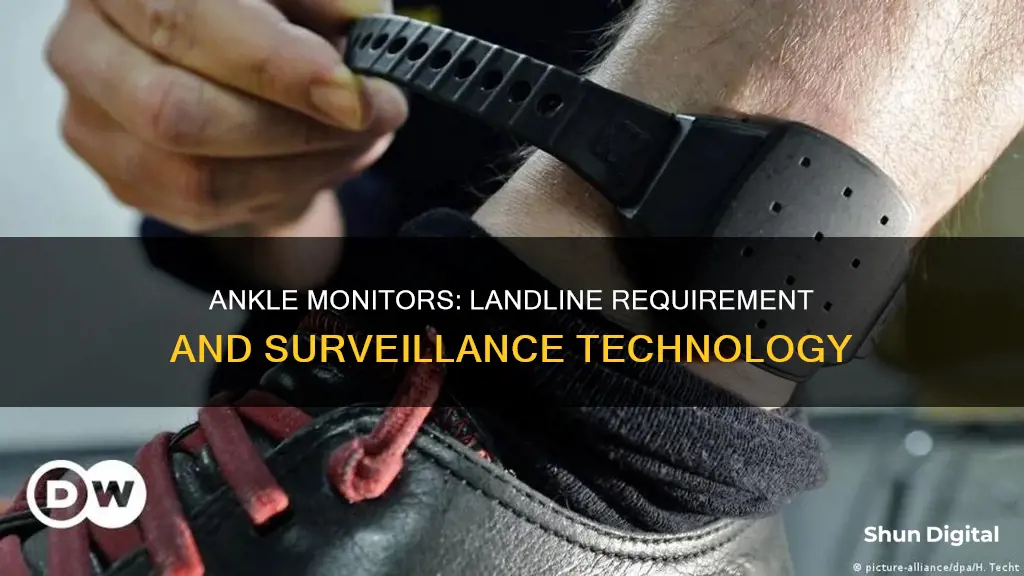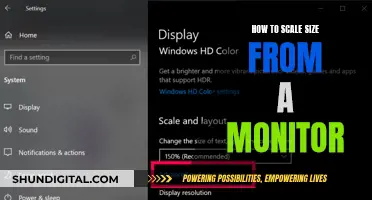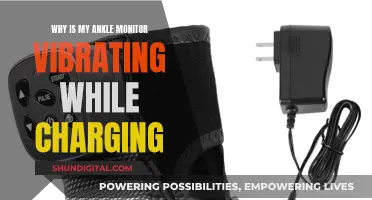
Ankle monitors are a form of surveillance used to track the movements and activities of individuals, including defendants awaiting trial and convicted offenders on parole or probation. They are often used as an alternative to imprisonment, allowing people to live in their homes and maintain some semblance of their regular lives. While ankle monitors do not have microphones, they can track location via GPS or RF technology, with the latter used primarily for those under house arrest or curfew. In some cases, a landline phone connection is required for the ankle monitor to function, but newer models may use cellular or Ethernet connections.
| Characteristics | Values |
|---|---|
| Required for ankle monitoring | Yes, in some cases |
| Network | Cellular or landline |
| Cost | $5-$25 per day |
| Installation cost | $25 (in county) or $50 (out of county but in service area) |
| Compatibility | Compatible with most cable services and standard telephone companies |
| Alternative | Ethernet-enabled base station |
What You'll Learn

Landline vs. cellular networks
Ankle monitors are used to track the movements and activities of defendants awaiting trial and convicted offenders on parole or probation. They work by using GPS and RF technology. While GPS allows for the continuous, real-time tracking of an individual, RF devices monitor the presence or absence of the wearer from an exact location.
In many states, the device requires a landline phone, which can add an extra cost to the person wearing it. However, some ankle monitors work through cellular networks.
Landlines are telephone connections that rely on physical wire connections. They are connected via copper cables using the traditional telephone system. The phone number is associated with a physical address. Landlines offer a stronger, more reliable call quality with clearer sound, especially in rural areas. They are also ideal during power outages as they have their own power supply. Additionally, landlines offer immediate emergency response since they are affiliated with a specific address. However, they are stationary and have limited mobility.
On the other hand, cellular networks, or mobile phones, use wireless connections and radio waves to communicate instead of physical cables. They are completely mobile within the service area of the cell phone provider. Modern cell phones can perform multiple tasks such as video chat, texting, and accessing the internet. However, they are susceptible to power outages and can be affected by factors like bad weather, high network traffic, and location.
Holter Monitor Removal: Understanding the CPT Code
You may want to see also

GPS and RF technology
Ankle monitors use GPS and RF technology to track an individual's location and movements. GPS, or Global Positioning System, uses GPS satellites, cellular towers, and/or Wi-Fi to detect the wearer's location. This technology is often used when enhanced supervision is required, such as when an individual needs to be monitored outside of their residence or when a third-party risk has been identified. GPS equipment can provide real-time tracking and notifications if the wearer enters a pre-determined excluded area.
RF, or Radio Frequency, technology is used to verify the presence or absence of an individual at an exact location, such as their residence. This technology is typically employed for those under house arrest or with a curfew. RF devices transmit constant radio signals back to a receiver, which is usually connected to a landline phone. If the wearer goes outside the designated area, the device vibrates and emits a loud tone, alerting the wearer. If they do not return to the designated area, the device sends an alert to the authorities.
SCRAM Systems, a provider of corrections technology, offers GPS ankle monitors with features such as long battery life, user-friendly software, and superior location accuracy. Their system also includes the SCRAM TouchPoint client mobile app, which improves client engagement and increases the efficiency of GPS monitoring programs. Another company, Connecticut Bail Bonds Group, offers bail bond services and provides information on how to make ankle monitors more comfortable, such as wearing loose-fitting clothing and using lotion to prevent skin irritation.
In summary, GPS and RF technology are integral components of ankle monitors, providing location tracking, supervision, and notification capabilities for authorities, while also allowing wearers to have some freedom of movement within designated areas.
Spin Bike Upgrade: Monitor Setup Guide
You may want to see also

Cost of monitoring
The cost of ankle monitor tracking is a controversial topic. In the US, people with ankle monitors are often required to pay to wear them. These fees can range from $5 to $25 per day and are imposed as a condition of probation, parole, diversion, or some other community-based sentence. In some states, failure to pay these fees can result in extended supervision, additional fees, or even a return to jail. This has sparked debate, with some arguing that monitoring fees exploit individuals who are trying to reintegrate into society.
The daily cost of monitoring programs can be calculated based on an individual's hourly rate, if employed, plus a hook-up fee that varies depending on location. For example, in Wayne County, the daily cost is equal to the individual's hourly rate plus a $25 hook-up fee for in-county residents or $50 for those out of the county but within the service area.
Additionally, the use of a landline telephone may add to the overall cost of monitoring. While SCRAM Systems have introduced Ethernet capability to their base stations, which communicate with the ankle bracelets, some states still require a landline connection. This requirement can result in additional costs for the individual being monitored, as they may need to subscribe to a landline phone service.
The cost of monitoring also includes the price of the equipment itself, such as the ankle bracelet and any other devices used for alcohol or location monitoring. These devices are typically provided by the monitoring company and may include features such as transdermal alcohol testing, automated facial recognition, and GPS location tracking.
Overall, the cost of ankle monitor tracking can be a significant financial burden for individuals who are already facing challenges associated with reintegration into society. While the fees vary depending on location and individual circumstances, they can have a substantial impact on an individual's ability to cover basic living expenses and successfully complete their monitoring program.
Removing the Base of an ASUS Monitor: A Step-by-Step Guide
You may want to see also

Medical procedures and the ankle monitor
Ankle monitors are often used as an alternative to traditional incarceration, allowing individuals to live in their homes instead of going to jail. They are used to track the movements and activities of defendants awaiting trial and convicted offenders on parole or probation. There are three main types of ankle monitors: Radio Frequency (RF), Global Positioning System (GPS), and Secure Continuous Remote Alcohol Monitoring (SCRAM).
When it comes to medical procedures, there are some important considerations for individuals wearing ankle monitors. Certain medical procedures, such as MRIs, X-rays, mammograms, and CT scans, may be incompatible with the ankle monitor device. This means that individuals with ankle monitors may face challenges or delays in accessing these medical procedures. It is crucial for those with ankle monitors to communicate their situation to medical professionals in advance to make the necessary arrangements.
In some cases, the ankle monitor may need to be temporarily removed or adjusted to accommodate the medical procedure. This process should be carefully coordinated with the relevant authorities and medical staff to ensure the individual's compliance with any court-ordered restrictions. It is important to note that tampering with or removing the ankle monitor without proper authorization is a punishable offense.
Additionally, individuals with ankle monitors may need to provide information about their medical appointments and travel to and from medical facilities. This is because ankle monitors are often used to enforce specific travel restrictions and curfews. Obtaining permission for any travel outside the permitted areas or schedules is essential to avoid legal consequences.
The use of ankle monitors in the medical context also raises privacy and data concerns. Ankle monitors collect and transmit sensitive location data, and individuals have expressed worries about who has access to this information. Ensuring the security and confidentiality of this data is crucial to protect the privacy rights of those under monitoring.
Furthermore, the cost of ankle monitors, which is typically borne by the wearer, can add a financial burden to medical procedures. In some states, the presence of a landline telephone is required for the ankle monitor, which can result in additional expenses. Any damage or loss of the device during medical procedures may also incur further costs for the wearer.
Best Retailers to Buy HP VH240a Monitor
You may want to see also

Data ownership
The use of GPS ankle monitors in the US criminal justice system is on the rise, with people wearing them more than doubling from 2005 to 2015. The devices are used to track the location of individuals to ensure they are complying with the terms of their release, such as being at home every night after a certain time or avoiding specific places.
The data generated by these monitors is typically owned and monitored by private companies contracted by local governments. These companies are responsible for tracking individuals' movements and alerting authorities if they violate the terms of their release. While the data is primarily used for surveillance and law enforcement purposes, there have been concerns raised about who has access to the information and how it is being used.
In terms of data ownership, it is important to note that the data generated by ankle monitors is typically owned by the company that provides the monitoring service. This has raised concerns about the lack of transparency and accountability in the industry. Private companies often have little to no public oversight, and there are questions about how they set fees, collect data, and ensure individuals comply with the terms of their release.
To address these concerns, some have called for stricter regulations and oversight of the ankle monitor industry. This includes ensuring data privacy and protection for those being monitored, as well as greater transparency and accountability from the companies involved. There are also calls to replace electronic monitoring with less restrictive measures, such as court reminders and transportation assistance, which could help reduce the negative impact on individuals' mental health and well-being.
Additionally, there are financial implications for those wearing the monitors, as they are often required to pay daily fees ranging from $3 to $35, which can be a significant burden, especially for those from marginalized communities. The high costs associated with ankle monitors have led to criticisms that they contribute to mass incarceration and create financial barriers for individuals trying to reintegrate into society.
Measuring LCD Monitors: Size, Resolution, and More
You may want to see also
Frequently asked questions
Ankle monitors require either a cellular or landline network to send signals to a probation officer. However, SCRAM Systems has added Ethernet capability to the base station used with its continuous alcohol monitoring and house arrest bracelets, so a landline is not always necessary.
If you don't have a landline, you may be able to use a cellular network instead. SCRAM Systems is the only corrections technology provider to offer an Ethernet-enabled base station, so this may be an option.
If you can't get Ethernet and don't have a landline, you may still be able to use a cellular network. However, this may depend on your location and whether a cellular signal can be received.
Using a landline with an ankle monitor can provide a more consistent connection than a cellular network, especially in areas with poor service. It can also help reduce costs for the individual wearing the ankle monitor, as they may not need to pay for a separate internet or phone plan.







